
* In the years before World War II, the Bell Aircraft Company developed a high-performance fighter of innovative design, the "P-39 Airacobra", featuring a mid-mounted engine. The P-39 would be produced in large numbers, though it would be most prominently used by the USSR; the same was true of the P-39's improved successor, the similar "P-63 Kingcobra". This document provides a history and description of the Airacobra and the Kingcobra.
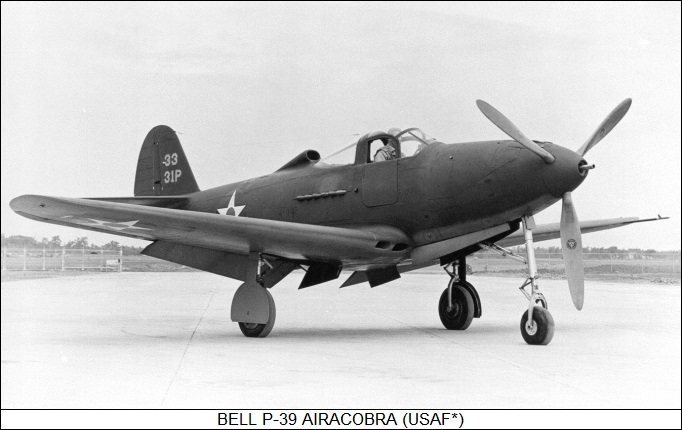
* Larry Bell had been born in Indiana in 1894, but his family moved to California when he was 13. In 1912, he went to work for aviation pioneer Glenn L. Martin, rising to the vice-president position of the Martin firm by 1920. Martin wasn't the easiest person to work for, and Bell knew he'd never get into a partnership position with the company -- so Bell quit in 1925. He couldn't get steady work for three years, but then he landed a job at Consolidated Aircraft in Buffalo, New York, rising to become general manager.
When Consolidated moved its operations to California, Bell decided to stay in Buffalo along with a cadre of like-minded individuals, forming Bell Aircraft in 1935. Later Bell would admit that naming the company after himself wasn't a good idea, since it made it more difficult to delegate authority, and found out that "when your name's out front, you have to do a lot of things that are a terrible bore."
The first product built by Bell was an extremely innovative machine, designed by a team under Bell chief engineer Robert Woods, named the "Airacuda", the name rhyming with "Barracuda". It was a "bomber destroyer", powered by twin Allison V-1710 water-cooled vee-12 engines, one mounted in a pusher fashion on each low-mounted wing. There was a glassed-in position in front of each engine nacelle, accommodating a gunner with a 37 millimeter cannon. There were two more 7.62-millimeter (0.30-caliber) Browning fixed machine guns in each nacelle, as well as a flexibly-mounted 12.7-millimeter (0.50-caliber) Browning machine gun in a blister position on each side of the rear fuselage, and the capability of dropping small parachute bombs or "aerial mines" to knock out enemy aircraft flying below.
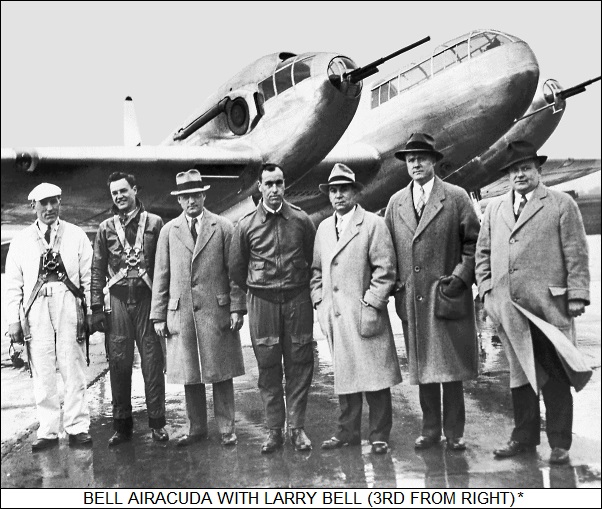
The Airacuda was very whizzy-looking by the standards of the time, very much fitting pulp science fiction concepts of the day -- and indeed it did make a popular splash, appearing on magazine covers, and even being duplicated as a die-cast toy. From a later perspective it looks pretty silly, which may be due to the benefit of hindsight -- but a TIME magazine article from 1943 called it "freakish-looking", suggesting the idea seemed dubious early on. The initial "XFM-1" prototype performed its first flight on 1 September 1937; it was followed by 12 "YFM-1" evaluation machines, with early examples featuring taildragger landing gear and later ones featuring tricycle landing gear. The Airacuda's performance was poor, its role unclear, while it was overcomplicated and unreliable; all of the aircraft were scrapped in 1942.
* In the meantime, Bell had been working on a single-seat fighter, the "Bell Model 3", in response to a 1936 US Army Air Corps (USAAC) requirement. As the design emerged, it was a low-wing monoplane with tricycle landing gear, then an unusual feature, with the engine unconventionally mounted in mid-fuselage, turning the propeller through a driveshaft. This arrangement, which had been used in a few earlier experimental aircraft, was seen as enhancing agility by placing the engine at the machine's center of gravity (CG), as well as permitting installation of heavy armament in the nose. There was some thought of putting the cockpit behind the engine, close to the tail -- but that was quickly judged unrealistic, with the cockpit moved forward of the engine, this revision being designated the "Model 4".
The Bell proposal was submitted to the Air Corps in May 1937, with the USAAC awarding a contract for a single prototype of what had by then become the Bell "Model 12", more formally "XP-39", in October of that year. Initial flight of the XP-39 prototype was on 6 April 1939, with test pilot James Taylor at the controls. The machine was named "Airacobra" -- note that the name was "Air-A-Cobra", not "Air-Cobra" as it is easily miswritten, the name clearly being assigned to echo the Airacuda name. In any case, this machine was powered by an Allison V-1710-17 engine with a turbocharger system, the Allison providing 860 kW (1,150 HP). The aircraft featured a scoop on each side of the engine for the turbocharger system. Armament was envisioned as two 12.7-millimeter and two 7.62-millimeter Brownings in the nose and a T-1 37-millimeter cannon firing through the prop hub -- though the XP-39 wasn't armed.
On the basis of satisfactory initial test flights, the Air Corps awarded Bell a contract to produce a dozen "YP-39" evaluation machines -- with the order then augmented with a 13th machine that was originally planned as the "XP-39A" -- to feature changes recommended in light of studies by the US National Advisory Committee for Aviation (NACA). While work went on to build these machines, the XP-39 was rebuilt to the "XP-39B" configuration, the primary change being that the turbocharger system was deleted, with the Allison engine reverting to its standard single-stage supercharger. The XP-39 was the only Airacobra to be fitted with a turbocharger system.
Sources are very confused as to why the decision to delete the turbocharger was made; one common claim is that the Air Corps didn't believe high-altitude performance was important to their requirements, and had concerns over the admitted complexity of the turbocharger. It seems a bit hard to believe that the Air Corps wouldn't have wanted good high-altitude performance if they could have got it, and they had no problems with the use of the same turbocharger on the P-38 Lightning; it appears that NACA wind tunnel experiments showed the XP-39 turbocharger installation was so aerodynamically cluttered that it did more harm than good. The XP-39B deleted the scoops for the turbocharger, and instead featured a small but distinctive carburetor intake on the spine of the aircraft. The re-born XP-39B performed its initial flight on 25 November 1939.
The first of the batch of YP-39s performed its initial flight on 13 September 1940, with all delivered by the end of the year. They also used a supercharger instead of turbocharger; the later YP-39 machines in the evaluation batch featured armament. Even before the first flight of YP-39, the Air Corps had ordered a batch of production machines, originally designated "P-45" but then designated "P-39C", their configuration being much like that of the armed YP-39s. The first P-39C flew in January 1941.
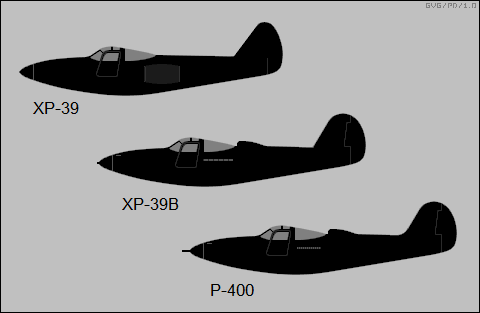
The P-39C really wasn't suitable for combat, lacking armor and self-sealing tanks. 80 had been ordered, but only 20 were built, combat reports from Europe indicating that the P-39C was simply not up to combat duty. The remaining 60 machines in the order were built with armor, self-sealing tanks, and enhanced armament as the "P-39D". The P-39C ended up being an evaluation type, with the P-39D being the first Airacobra to go into formal service with the Army Air Corps. It would also be the first "Cobra" variant to see action.
BACK_TO_TOP* From the P-39D onward, the Airacobra family did not change radically in configuration, so the P-39D makes a good baseline for the type. The P-39D was, as mentioned, of low-wing configuration with a broadly conventional layout -- differing from convention with the centrally-fitted Allison engine and its driveshaft (implying a transmission hump up through the cockpit), tricycle landing gear, and the eccentric feature that the pilot got in and out of the cockpit through a car-style side door, with a door on each side. The doors even had roll-down windshields. They made access to the aircraft easy, though they also made escape a bit tricky in a pinch; apparently they were rigged so they could be discarded to simplify bailing out.
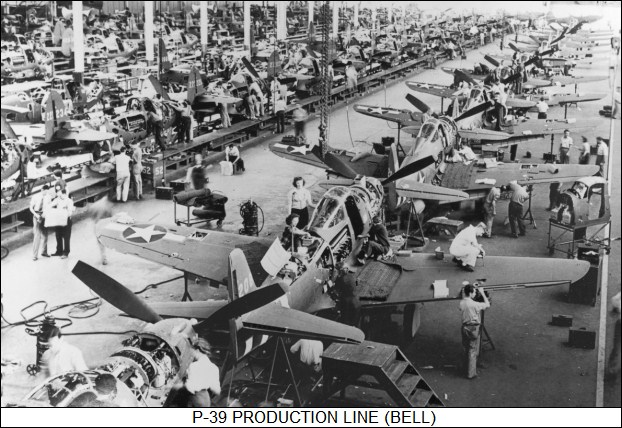
Construction was mostly of aircraft aluminum, with some magnesium parts and fabric-covered flight surfaces. All the landing gear assemblies had single wheels, with the nose wheel castoring and ground steering by differential braking. The nose gear retracted backward, and the main gear hinged in the wings to pivot towards the fuselage. The engine was a V-1710-35 Allison, also with 860 kW (1,150 HP) but with technical improvements, driving a three-bladed Curtiss Electric variable-pitch propeller. Self-sealing fuel tanks were fitted in the wings; trim considerations made installing fuel tanks in the fuselage problematic, the engine preventing them from being installed on the CG, and the relatively small size of the wing tanks meant modest range. Armament consisted of:
There was a centerline stores rack, capable of handling stores of up to 225 kilograms (500 pounds). Although the P-39D was used for trials of various configurations of belly tanks for ferry flights, it is unclear if the P-39D ever carried a belly tank in service.
___________________________________________________________________
BELL P-39D:
___________________________________________________________________
wingspan:
10.36 meters (34 feet)
wing area:
19.79 sq_meters (213 sq_feet)
length:
9.19 meters (30 feet 2 inches)
height:
3.61 meters (11 feet 10 inches)
empty weight:
2,475 kilograms (5,460 pounds)
MTO weight:
3,720 kilograms (8,200 pounds)
max speed:
580 KPH (360 MPH / 315 KT)
service ceiling:
10,000 meters (33,000 feet)
range:
960 kilometers (600 MI / 520 NMI)
___________________________________________________________________
* A total of 429 baseline P-39Ds was built, followed by 336 "P-39D-1" machines, the primary difference being replacement of the M4 37-millimeter nose cannon with a 20-millimeter Hispano Mk.404 cannon with 60 rounds of ammunition. It appears the substitution was due to production difficulties with the 37-millimeter cannon. The P-39D-1 also featured a small fillet on the front of the tailfin where it merged with the top of the fuselage; sources are a bit unclear as to whether the fillet was actually fitted to the baseline P-39D, but it certainly didn't appear on the P-39C.
Following the P-39D-1, Bell built 158 "P-39D-2" machines, much the same as the P-39D-1 but with very minor tweaks. In addition, a total of 26 P-39D-series aircraft was converted to a photo-reconnaissance configuration, the "P-39D-3", by placing two cameras in the aft fuselage and adding a bit of armor. It is unclear if they retained full armament. They were followed by 11 similar "P-39D-4" conversions. Total production of the D-series was 429 + 336 + 158 = 923 aircraft.
BACK_TO_TOP* Roughly in parallel with P-39D production, Bell manufactured a total of 675 "P-400" Airacobras for export. The French had bought a batch of P-400s in April 1940; the order was taken over by the British after the fall of France a few months later, with the British then substantially increasing the buy. The P-400 was very similar to the P-39D-1, with the 20-millimeter Hispano cannon, but instead of 7.62-millimeter Brownings in the wings, it featured 7.7-millimeter (0.303-caliber) Brownings for compatibility with British ammunition.
However, British expectations of the "Airacobra I" -- as it was designated in Royal Air Force (RAF) service -- had been set by performance figures established by the unarmed and unarmored XP-39 prototype. On evaluation, the P-400 turned out to be about 10% slower than advertised, and of course its high-altitude performance was pathetic. It should be noted, however, that Bell engineers were correct in believing the mid-mounted engine was good for maneuverability, the RAF report concluding that an Airacobra could easily out-turn a Messerchmitt Bf 109.
Only a portion of the P-400 order was delivered to the UK, serving for a short time with RAF Number 601 Squadron, "City Of London". The remainder of the batch was shipped to the USSR or was taken into US Army Air Forces (USAAF) service -- the "Air Corps" having been superseded by the "Air Forces" in June 1941. The P-400s saw combat in the South Pacific; it is likely they were fitted with 7.62-millimeter Brownings for ammunition compatibility, though sources are unclear on the matter.
* The P-39D left something to be desired in service, suffering from a range of teething problems such as gear that was unreliable or froze up and other deficiencies. Deficiencies were addressed in subsequent variants, initially with a confusing list of P-39 variants built in small or relatively limited numbers:
* All these variants were simply a warmup to the "P-39N", with almost as many P-39Ns built as the sum of all earlier variant production. The baseline P-39N featured a V-1710-85 engine and a 3.18-meter (10 foot 4 inch) Aeroproducts prop; a P-39K was modified as the series prototype. 500 of P-39Ns were built, with all but the first 160 featuring elimination of three internal fuel cells to reduce weight. The P-39N could of course carry an external tank to compensate for the smaller internal fuel load, and service units that wanted the full internal fuel load back could install a field upgrade kit to restore the deleted fuel cells. Several further P-39N subvariants were built:
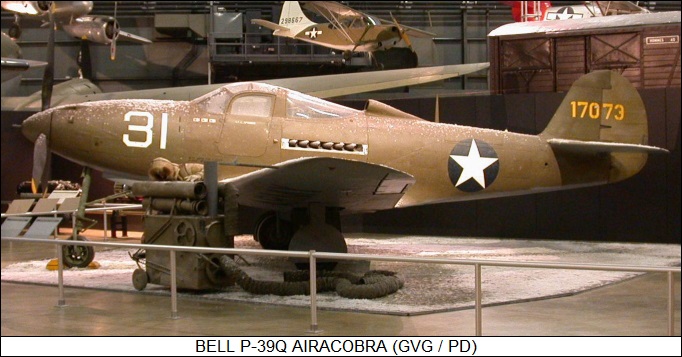
* The actual definitive Airacobra variant, however, was the "P-39Q", with more P-39Qs built than the rest of P-39 production put together. Subvariants included:
The list below summarizes Airacobra variants and production:
That gave total production of 9,589 Airacobras.
BACK_TO_TOP* The US was abruptly thrown into World War II on 7 December 1941, and spent much of 1942 simply trying to stave off disaster while preparing to take the offensive. The P-39 was one of the weapons available at the time, seeing service in the South Pacific, in the Aleutians, and in North Africa and Italy.
In USAAF hands, its record was mixed: it was sturdy and well-armed, but its high-altitude performance was poor and its centrally-mounted engine led to handling problems. The difficulty was that after ammunition was expended, the aircraft's CG shifted back so that the aircraft was inclined to fly tail-first, throwing it into a flat spin from which recovery was problematic. Bailing out under such conditions was also troublesome, because the pilot had a tendency to hit the tail. Even if recovery were possible, the spin had a tendency to warp the aircraft's tail, rendering the controls useless, which is why the P-39Q-25 introduced a reinforced rear fuselage.
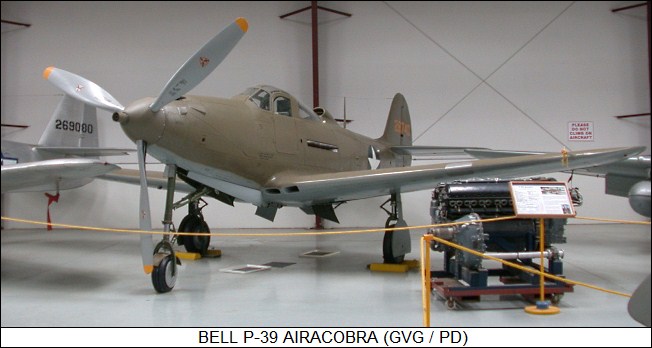
Still, the aircraft's firepower was impressive. Many sources say the 37-millimeter cannon was inclined to jams, but the significance of that problem is disputed; nobody disputes that any enemy target that took a solid hit from the cannon wasn't going anywhere but down. The Airacobra's low-altitude performance was also good, being regarded as a peppy little aircraft at the low level -- and certainly nobody could fault it for looks, with its elegant curved lines. One USAAF pilot, Lieutenant Bill Fiedler, became an ace in the Airacobra, while several other USAAF pilots scored kills with it. However, to the Army Air Forces the Airacobra was an "also-ran"; the P-39 was ultimately relegated to training and other rear-area roles in USAAF service.
* There were several minor export users:
* It was the Soviet Union that made the most of the Airacobra, obtaining roughly half the P-39s built, over 5,500 -- over a quarter of the number of Lend-Lease aircraft sent to the USSR, more than any other type. While early on they came in through a variety of routes, eventually they were generally air-ferried from the USA through Alaska and Siberia, generally by Soviet pilots, many of them women.
The Red Air Force put the Airacobra to very good use. In fact, in hindsight the P-39 could almost be regarded as a Soviet aircraft that the Americans had contracted to build for the USSR; at one point, Soviet dictator Josef Stalin wrote a personal letter to US President Franklin Roosevelt asking for more P-39s.
While a myth has persisted that the Red Air Force used the P-39 for close support, it was actually employed as an air combat machine. The Soviets had a much better close-support aircraft, the brutish Il-2 Shturmovik; the US only supplied the Red Air Force with high-explosive 37-millimeter rounds, not armor-piercing rounds. The tale of the P-39 as a close-support aircraft in the war on the Eastern front appears to have been promoted by references to its use in "tactical support" -- which in Soviet usage simply meant it was flown in association with ground force operations, not necessarily implying close-support duties.
Many of the top Soviet aces flew the "Kobruschka (Sweet Little Cobra)", including Grigory Rechkalov, who scored 57 victories, most of them inflicted by the P-39, and the well-known Aleksandr Pokryshin, with 53 victories, again most being obtained with the P-39. One Red Air Force pilot, Mikhail Baronov, scored one of his 28 total "kills" by chopping off the tail of a Bf-109 over Stalingrad with the prop of his P-39. Some claim the P-39 was the best-liked of all Western aircraft obtained by the Red Air Force.
Why the dramatic difference between the US and Soviet experience with the P-39? It wasn't a question of the Red Air Force being up against a weaker opponent; the German Luftwaffe was never a pushover for any Allied air forces. Part of the reason was that the Red Air Force was a tactical air arm, its primary mission being battlefield support of Red Army ground forces, and as a result air combat tended to be at low altitudes. Under such conditions, the P-39 could fight on at least equal terms with the Luftwaffe's Messerschmitt Bf 109F and its successor variants, as well as the Focke-Wulf Fw 190 -- which was not noted for its high-altitude performance either.
Another reason was that the Red Air Force thoroughly evaluated the Airacobra before putting it into service, finding out the hard way about its vicious spin characteristics, with several test pilots killed. The faults were documented, however, with rules for flying the aircraft written up for operational pilots -- they were warned to never perform aerobatics if they had expended their ammunition -- and training implemented to make sure P-39 pilots knew how to avoid spins and, when possible, head them off before the point of no return. Procedures had to be devised for maintenance in extreme cold conditions. Bell engineers went to the USSR to assist the Soviets in qualifying the P-39, obtaining feedback for refinements to the design.
* Some late-model P-39s supplied to the USSR remained in service into the early 1950s, a testimony to Soviet fondness for the machine. Some were refitted with Soviet armament of a single Berezin 20-millimeter cannon and twin Berezin 12.7-millimeter UBS machine guns; a few were even fitted with the Klimov M-105P vee-12 engine, which had a similar form-factor to the Allison V-1710.
Before America began supplying Airacobras to the USSR, the Soviets even thought of copying it, finding the reports on its design of great interest. The first concept for doing so was proposed in 1939, with well-known aviation designer Pavel O. Sukhoi sketching out a concept much along the lines of the P-39. That came to nothing, but in 1940, another aircraft designer named Mikhail I. Gudkov came up with his design for what would now be called an Airacobra "clone", the "Gu-1".
The Gu-1 had the exact same general layout as the P-39 -- mid-mounted vee-12 engine, tricycle landing gear, a cannon firing through the prop hub, two heavy machine guns in the nose, and four light machine guns in the wing. Its lines and details were distinctly Soviet, however, one major difference being that it didn't have the P-39's car-style doors. A prototype was actually built after an extended development, performing its first flight on 12 June 1943 -- with the flight ending in a crash that killed the pilot, Aleksey I. Nikashin. That was the end of the program, though Gudkov also proposed a "Gu-2" interceptor along the same lines, featuring very heavy armament, including a 45-millimeter Shpital'niy cannon firing through the prop hub. It didn't happen.
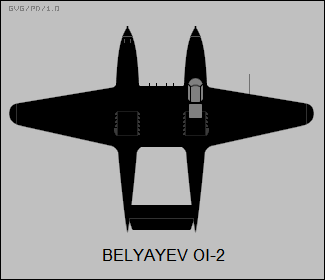
In 1941 yet another Soviet aircraft designer, Viktor N. Belyayev, came up with a design for a "twin Airacobra", the "OI-2", the configuration mating two P-39 clones together with a center wing section, though only the right fuselage had a cockpit. The basic configuration looked much more like a P-39 than the Gu-1, even featuring the car-style doors. It was to be powered by twin vee-18 Klimov M-120UV engines with 1,340 kW (1,800 HP) each, with a Taubin 23-millimeter cannon firing out each prop hub, four UBS 12.7-millimeter machine guns firing through the prop arc in the left fuselage, four ShKAS 7.62-millimeter machine guns in the wing center section, and a capability for external loads of up a total of 500 kilograms (1,100 pounds). It was certainly an interesting idea and impressively capable on paper -- but it didn't get off the drawing board.
BACK_TO_TOP* Given some of the Airacobra's vices, it wasn't surprising that the services flying the machine thought a two-seat trainer would be useful in teaching novice pilots how to fly the machine. Bell responded by modifying a P-39Q-5 to "TP-39Q-5" configuration by removing the armament, adding a forward cockpit with a side-hinged canopy up front for a flight instructor, and adding a ventral strake under the tail and an extended forward tailfin fillet to deal with aerodynamic changes. It was rolled out in September 1943.
That experiment proving satisfactory, Bell converted 12 P-39Q-20 machines to a similar "RP-39Q-22" configuration, the "R" indicated "restricted", as in not suitable for combat. A few were supplied to the USSR; the Red Air Force thought it a good idea, and so cooked up a few Airacobra trainer conversions of their own, designated "UTI P-39"; they had a different forward canopy arrangement.
Two P-39Qs were actually obtained by the US Navy for use as radio-controlled drones, being initially designated "XTDL-1" and then "XF2L-1K". Some Airacobras ended up on the civilian racing circuit for a time after the war. A fair number of P-39s still survive on static display, and one or two are even still flying.
* Bell was enthusiastic enough about the Airacobra to develop a prototype of a carrier-based variant in response to a US Navy request, resulting in the construction of a single "XFL-1 Airabonita" -- first flight being on 13 May 1940, with test pilot Brian Sparks at the controls.
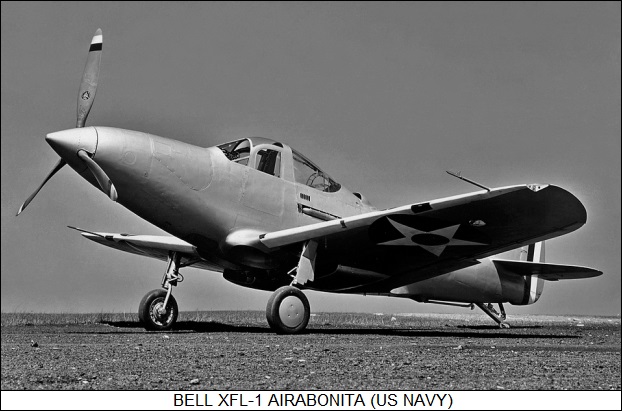
The Airabonita was clearly a member of the Airacobra stable, the main difference being that it had taildragger landing gear and an arresting hook, forward of the tailwheel. All landing gear assemblies retracted, the main gear being placed closer to the wing leading edge than on the P-39. The Airabonita also had a raised cockpit to improve field of view for carrier landings. The prototype was unarmed. The Navy began trials on the Airabonita in July 1940, revealing severe balance problems; the problems were addressed, with testing not resuming until the early spring of 1941.
By that time, the Navy had settled on the Vought F4U Corsair to meet the service's requirement for an advanced fighter. The Navy had never liked water-cooled engines much in the first place, and so the Airabonita program was canceled in May 1941, with the aircraft judged "unsatisfactory as a carrier fighter". It was scrapped the next year.
BACK_TO_TOP* During 1941, the Bell company began to rethink the P-39 design, with one of these rethinkings emerging as the unsuccessful XP-39E. Another line of investigation resulted in a USAAF contract for two "XP-63" prototypes awarded in June 1941.
Getting the XP-63 into the air proved troublesome, however; Bell was distracted by producing the P-39 in volume, and the initial XP-63 design turned out to be badly overweight, demanding a redesign. The first XP-63 flew on 7 December 1942, a year to the day after Pearl Harbor, though the aircraft was lost in a crash a few weeks later. The second prototype took to the air in February 1943, but was lost in a crash in May. Fortunately for the program, a third prototype had been ordered in mid-1942, and was flying in late April 1943. Even before the flight of the first prototype the USAAF had ordered the type into production, with the first "P-63A Kingcobra" machines rolled out in October 1943.
As it emerged, the P-63 was similar enough to the P-39Q to be mistaken for it, the P-63A being a low-wing aircraft with tricycle landing gear, mid-mounted Allison engine, car doors on each side of the cockpit, and armament consisting of a 37-millimeter cannon firing through the prop hub, two 12.7-millimeter Brownings on top of the nose, and a single 12.7-millimeter Browning in a fairing under each wing, for a total of five guns.
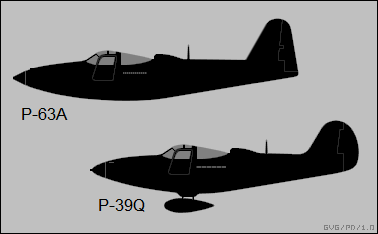
The P-63 was, however, a generally new design, featuring little parts commonality with the P-39. The P-63 was slightly longer than the P-39, with the most distinctive recognition feature being that the trailing edge of the rudder on the P-63 was straight, while it was rounded on the P-39; the P-63's tailfin was also taller. Another distinctive recognition feature was a four-bladed prop.
Other changes were subtler. The wingspan and wing area were increased, and the wing featured the new "laminar" airfoil configuration established by NACA. More importantly, the P-63 was powered by an Allison V-1710-93 engine with a second supercharger stage -- not a turbocharger, as indicated in some sources -- giving it good high altitude performance. It appears that the P-63, just as with the XP-39E, was originally slated to be powered by the Continental V-1430 engine, which as noted was a nonstarter.
___________________________________________________________________
BELL P-63A KINGCOBRA:
___________________________________________________________________
wingspan:
11.68 meters (38 feet 4 inches)
wing area:
23.04 sq_meters (248 sq_feet)
length:
9.96 meters (32 feet 8 inches)
height:
3.84 meters (12 feet 7 inches)
empty weight:
2,892 kilograms (6,375 pounds)
MTO weight:
4,763 kilograms (10,000 pounds)
max speed at altitude:
660 KPH (410 MPH / 355 KT)
service ceiling:
13,100 meters (43,000 feet)
range:
725 kilometers (450 MI / 390 NMI)
___________________________________________________________________
USAAF evaluation of the Kingcobra was positive, but the service felt no particular need for the aircraft as a frontline fighter, and so it was built primarily for Soviet use -- indeed, much of the tweaking of the P-63 design was performed in response to Red Air Force inputs.
BACK_TO_TOP* A total of 50 initial production P-63A-1 machines was built. They were followed by improved subvariants:
Although the P-63 was never used in combat by the USAAF, the service did use it as a piloted gunnery target, the "RP-63". Five P-63A-9s were initially built as "RP-63A-11" targets, with armor but no armament. They featured the rear cockpit glazing faired over, a modified carburetor scoop, and were fitted with a light on the prop spinner and on each side coupled to an array of sensors that would cause the lights to flash when the aircraft was hit by special "frangible" ammunition broke up on impact. The primary rationale was to train gunners on bombers to counter fighter attacks.
The RP-63A-11s were followed by 95 "RP-63-12" targets based on the P-63-10. The RP-63s were painted bright orange and were nicknamed "Pinballs". Sometimes they towed target sleeves instead of being used as targets themselves. Including the Pinballs, a total of 50 + 20 + 130 + 150 + 200 + 445 + 730 + 5 + 95 = 1,825 P-63A machines was built.
* A "P-63B" variant with a Rolls-Royce Merlin engine was considered but never built, and so the next Kingcobra variant was the "P-63C". It was similar to the P-63A-10 but featured an improved V-1710-117 engine, wingspan clipped by 25 centimeters (10 inches) and, after early production at least, a prominent ventral fin to improve yaw stability; it is unclear if the fin helped reduce the aircraft's propensity to spin. The "P-63C-1" was the initial production subvariant, with 215 built; they were followed by 1,012 "P-63C-5" machines with minor improvements. 200 more P-63C-1 machines were manufactured as "RP-63C-2" Pinball targets, for a total of 215 + 1,012 + 200 = 1,427 P-63C machines built.
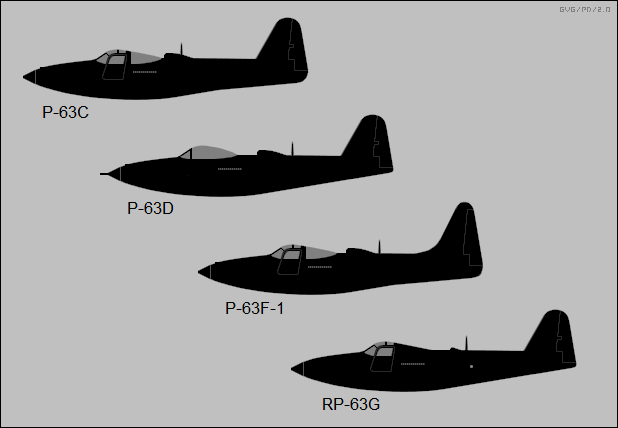
Only one "P-63D" -- technically a "P-63D-1" -- was built. It was similar to the P-63A-10, with no ventral fin, but featured a bubble canopy and the carburetor intake moved back, presumably to allow the canopy to be slid back to open. The wingspan was increased over that of the P-63A, to 11.94 meters (39 feet 2 inches); the P-63D was powered by an Allison V-1710-109. The aircraft was lost in a crash due to an engine fire that claimed the life of pilot Bob Borchardt.
The P-63D was followed by the "P-63E", which was along the lines of the P-63C-10, with the ventral fin and the M10 cannon, but with the wider wingspan, stepped-back carburetor intake, and V-1710-109 engine of the P-63D. It retained the old car-door cockpit scheme; it featured more fuel capacity and a new Aeroproducts propeller. Only 13 "P-63D-1" machines were built; there was thought of a "P-63D-5" variant with the bubble canopy, but with the end of the war P-63 production was wound down. A single "P-63F-1" was built on an experimental basis, being essentially a P-63E with a number of tweaks, most prominently a substantially taller tailfin.
The final production version of the Kingcobra was the "RP-63G" Pinball target, with 32 built, for a total of 100 + 200 + 32 = 332 Pinballs. The Pinballs lingered on in service after the war, but were generally retired in 1947. There was work towards a "P-63H" with a new Allison "Turbo-Compound" V-1710 with both two-stage supercharging and a turbocharger, but the jet age overtook it, and it never happened.
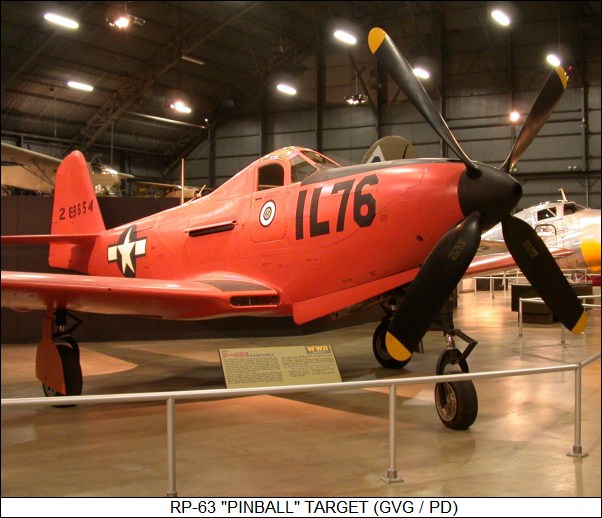
* The following list summarizes Kingcobra production:
That gave total production of 3,302 Kingcobras.
BACK_TO_TOP* As mentioned, the Soviets were the primary users of the P-63, obtaining about 2,400, ferried by air over the Siberia route. P-63s shipped to the USSR never saw combat against the Nazi Reich; the Soviets had plenty of fighter aircraft at the time, and being intent on performing a thorough evaluation of the Kingcobra before putting it into service, did not provide it to frontline units before the Nazi surrender in May 1945. Some Red Air Force pilots recollected seeing P-63s in service against the Germans, but no records confirm this.
The P-63 did, however, see action in the brief Soviet campaign against the Japanese before Japan's surrender in August 1945, primarily being used for escort and ground attack; there was little air-to-air conflict in that fight, because the Japanese didn't have many fighters left to send up against the Red Air Force. Soviet pilots liked the Kingcobra, seeing it as a bigger and better Airacobra, though it retained the nasty spin characteristics of the P-39.
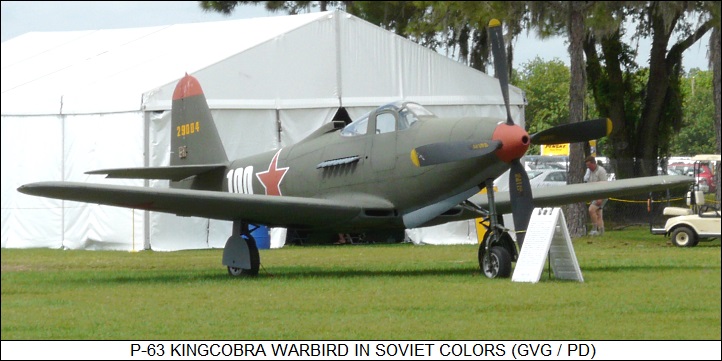
After the war, the P-63 remained in first-line Red Air Force service. It was seen as very useful in helping pilots convert to new jet fighters as they came into service, since the jets generally had tricycle landing gear, and the P-63 was an exception among Red Air Force piston fighters in that it had tricycle landing gear as well. The Kingcobra lingered on the flightlines into the early 1950s. There are tales that US pilots encountered them during the war in Korea, but no documentation confirms that notion.
The only other serious export user of the Kingcobra was the French Armee de l'Aire, which received 114 P-63Cs at the end of World War II. They served in combat as ground-attack aircraft in the French war in Indochina, being finally retired in 1951 in favor of US-supplied Grumman F8F Bearcat piston fighters. Some P-63s lingered in liaison and other secondary roles for a few years after that.
* There were a number of special versions and modifications of the P-63:
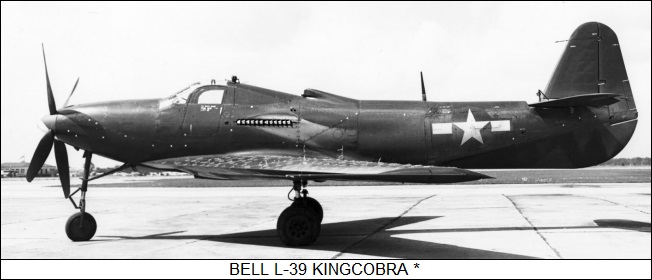
* The Kingcobra was out of military service by the mid-1950s, but a few surplus P-63s did have a new career as air racers in the postwar period. A number of Kingcobras survive as museum displays, while a few remain flying as airshow "warbirds".
BACK_TO_TOP* Besides the Airacuda and Airacobra / Kingcobra, the only purely piston-powered fighter developed by Bell was the "XP-77". It started life in 1941 as a design to meet a military requirement for a lightweight fighter with the general specifications of "400 HP, 4,000 pounds, 400 MPH", Bell consequently naming their concept the "Tri-4". In the spring of 1942, the USAAF ordered a batch of 25 Tri-4 fighters -- but development proved troublesome, and the first "XP-77" didn't perform its initial flight until 1 April 1944, test pilot Jack Woolams at the controls.
As it emerged, the XP-77 was a tidy little aircraft, made largely of wood, with a configuration patterned on prewar air racers. It had a length of 6.97 meters (22 feet 10 inches), a wingspan of 8.38 meters (27 feet 6 inches), an empty weight of 1,295 kilograms (2,855 pounds), and a maximum take-off weight of 1,828 kilograms (4,029 pounds). It was built around a Ranger air-cooled 12-cylinder inverted vee engine driving a two-bladed prop, with a low-mounted wing, conventional tail arrangement, canopy set well back, and tricycle landing gear. The landing gear all had single wheels, the nose gear retracting back, the main gear hinging in the wings to retract towards the fuselage. Armament was a single 12.7-millimeter Browning machine gun in each wing and, optionally, a 135-kilogram (300-pound) bomb carried on the centerline.
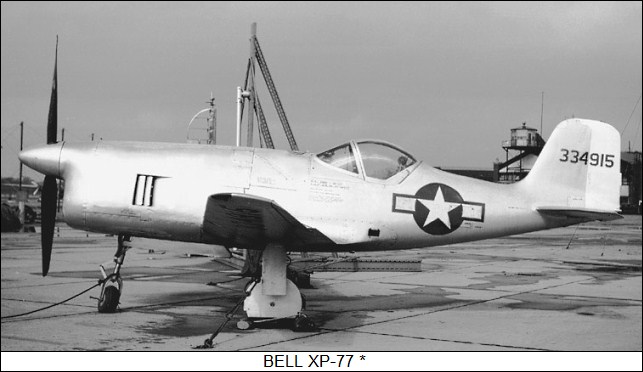
By the time the HP-77 flew, the USAAF had lost interest in the program, and it only went to flight test on an experimental basis. One of the problems with the program was that air racers rarely provided a useful basis for a combat aircraft, any more than a race car provides a reasonable basis for a combat vehicle. Air racers don't need armor, armament, or maneuverability, and unless they're designed for long-distance races, they don't need range either. Trying to add such features to an air racer tended to produce a design inferior to a purpose-built combat aircraft -- and by the time the XP-77 flew, it was absolutely no match for contemporary production fighters, with a top speed of only 530 KPH (330 MPH / 285 KT).
More importantly, the requirement for which the XP-77 was built turned out to be irrelevant, there being no useful purpose in building a "toy" fighter with minimal armament and combat capability, even if it had performed as hoped. A second XP-77 took to the air in July 1944, but was lost in a crash on 2 October, the pilot bailing out. That was the effective end of the program, the effort being formally given the axe two months later. The second prototype was eventually scrapped. Bell did also develop several jet fighters, as well as pioneering experimental rocket planes such as the X-1 -- but the company's real future was in helicopters.
BACK_TO_TOP* I've long been fascinated by the P-39 / P-63 -- its unorthodox configuration is interesting. Was it a good aircraft? On the balance, it appears to have been a machine with many virtues that was very effective, but saddled with some significant faults. As usual, trying to nail down production quantities exactly is an exercise in frustration, but the figures given here can be regarded as in the ballpark.
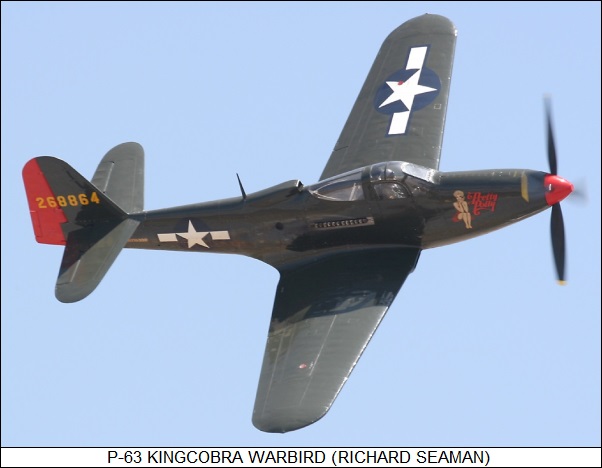
* Sources include:
* Revision history:
v1.0.0 / 01 aug 11 v1.0.1 / 01 jul 13 / Review & polish. v1.0.2 / 01 jun 15 / Review & polish. v1.0.3 / 01 may 17 / Review & polish. v1.0.4 / 01 apr 19 / Review & polish. v1.0.5 / 01 feb 21 / Review & polish. v1.0.6 / 01 dec 22 / Review & polish. v1.0.6 / 01 nov 23 / Review & polish. (*)BACK_TO_TOP
